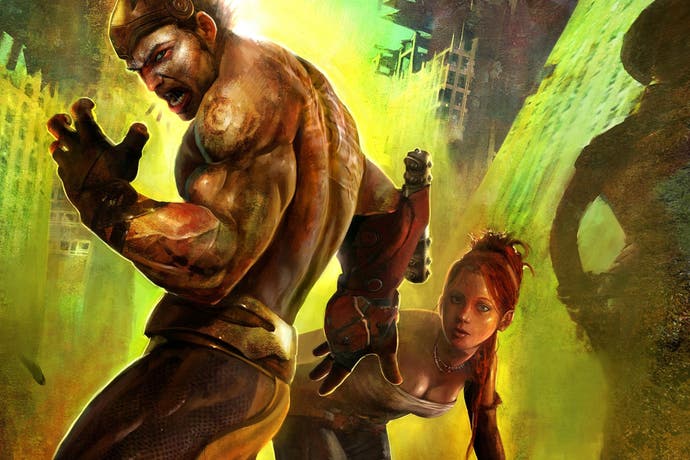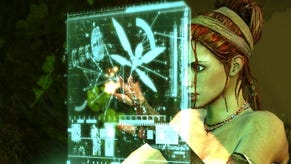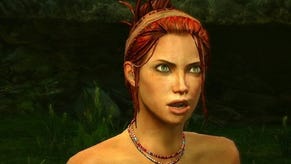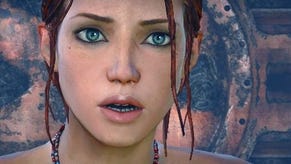Enslaved: Odyssey to the West review
To celebrate the PC release of Ninja Theory's breezy adventure, our original review plus the verdict on its DLC expansion.
Enslaved: Odyssey to the West was a modest success when it launched in 2010. Modest in sales, that is - the few that played Ninja Theory's breezy adventure have often become passionate fans of it. Namco Bandai's hoping to convert more players as it finally brings it to PC this week. To celebrate, here's our original review.
The first half-hour of Enslaved: Odyssey to the West could bring out the jaded cynic in any action adventure fan. Here we go again, you think, as the camera pans round yet another corridor on yet another rusty old spaceship.
Oh look, a gruff, spiky-haired, shirtless man with shoulders bigger than his head. He's got abs you could take a brass rubbing from and he's wielding a big stick. Must be our hero, then.
And here's his sidekick, a hot redhead who's good for nothing but hacking computers to open laser doors. When she's not doing that she's staring wide-eyed and open-mouthed at the muscley bloke, perhaps wondering if she recognises him from the Gay Xchange ad. She's got a bottom you could bounce breeze blocks off and she's all tight trousers and boob tubes. (Once, just once, it would be nice to see a female game character wearing a fleece.)
The setting is familiar too. Here we are in yet another post-apocalyptic US city. It's New York this time, and there's some business with planes crashing into skyscrapers and tattered American flags. Just to hammer the point home there's a municipal monument covered in photographs of missing people, a device which might be more effective at evoking a sense of loss if it hadn't been used in every disaster film made since September 2001.
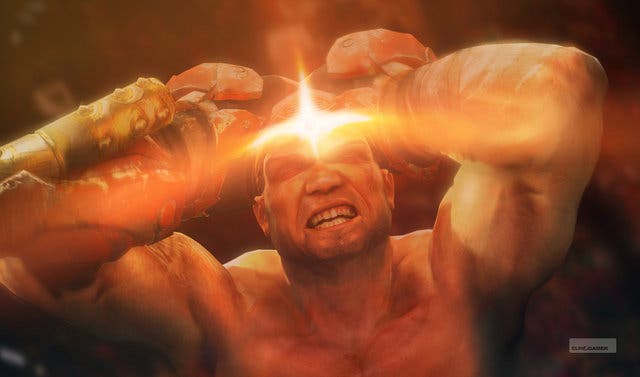
All right, that's enough scorn-pouring. Because although the first half hour of Enslaved would get anyone's snidey-sense tingling, what follows deserves more attention. As the game unfolds, you realise this isn't just another average action adventure. Yes, there are a fair few clichés and ideas we've seen before here, but it's still much more interesting and absorbing than it first appears. In short, Enslaved is a bit special.
This is partly down to the high production values. Celebrity involvement is no guarantee a game will be any good (for evidence, see Vin Diesel's Wheelman, Tony Hawk's RIDE and anything involving an Olsen). In this case, however, it's paid off.
Nitin Sawhney's impressive orchestral score truly enhances the gameplay experience, whether you're engaged in a tense bit of platforming accompanied by nervous strings or bowling around on a hoverboard to some jolly choral music. Andy Serkis, old Gollumface himself, performed the motion capture, and it shows in the impressive fluidity, agility and grace with which the main character moves around.
Then there's the story, which was co-written by Alex Garland - best known for penning The Beach and 28 Days Later. Which brings us to the really big news: Enslaved, despite being a videogame, does not feature a script which makes you want to rip your own face off and use it as a hanky into which to weep over such a crime against decent narrative structure and remotely believable dialogue.
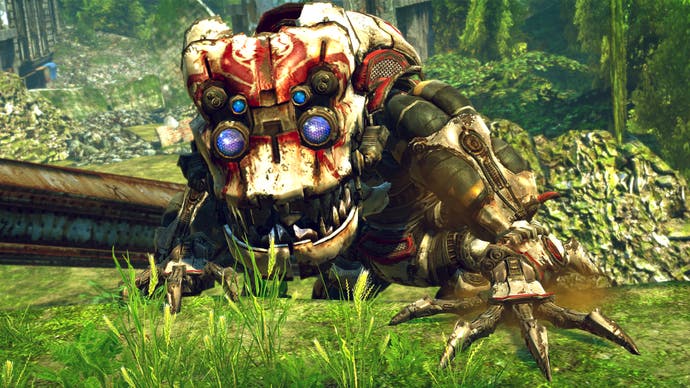
Again, there are a few clichés. But, unlike so many games, Enslaved resists the temptation to make the characters endlessly explain what's going on and how they're feeling about it in long, convoluted sentences no one would ever say in real life.
Cut-scenes are short, well-paced and brilliantly acted, both in terms of the voice performances and the facial animations. The relationships between the characters are believable and there are some genuinely touching moments.
Ninja Theory seems to understand that, just like in the movies, what is left unsaid can have more of an impact than what is said. They know some things are more effectively conveyed by the raise of an eyebrow than a dozen lines of poorly lip-synced dialogue.
On top of all that, the plot is good. This might be because it's based on a classic story - ancient Chinese legend Journey to the West. (This was also the inspiration for Monkey, the Japanese TV series which, throughout the eighties, terrified small girls who were just waiting for The Smurfs to come on and had nightmares about being eaten by Pigsy.)
There's a sci-fi twist however - Enslaved is set in the USA, 150 years from now. War has ravaged the land, murderous mechs roam the streets, Ocado has stopped doing deliveries and any humans found alive are rounded up and bundled onto slave ships.
Which is how Monkey meets Trip, the hot redhead. They manage to escape their ship alive though, in Monkey's case, unconscious. Aware that hacking computers and opening laser doors isn't going to get her far when faced with armies of machine gun-wielding robots, Trip fits Monkey with an electronic slave headband. In doing so she condemns him to protect her; if Trip's heart stops beating, the headband will kill Monkey. Clever girl.
That's just one example of how, refreshingly, there's been an attempt to introduce believable logic to the world of Enslaved. Monkey isn't following Trip around because he fancies her, or because of some sense of chivalry regarding vulnerable women he's borrowed from 1952 - he's doing it because he has to.
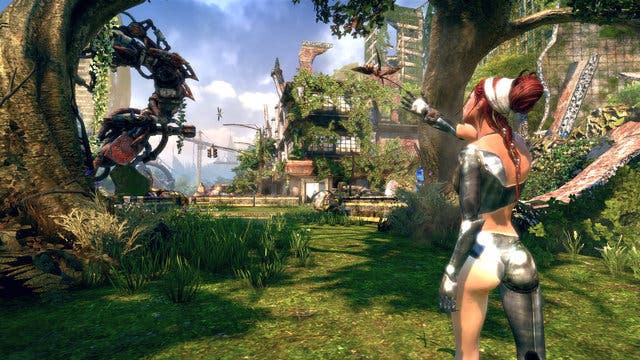
Similarly, enemies don't appear from nowhere or stalk around waiting for something to happen. The mechs are only activated when trouble starts. The way you can see them sitting still and silent from far away, knowing they'll jump into action the moment you step too close, creates a tense dynamic.
At one point a character asks, "Why do the mechs try to kill us?" Another replies, "It's all they know." How many videogames can you recall which attempt to address the issue of why you're being endlessly attacked by robots / aliens / zombies / Nazis? (All right, it's pretty obvious with the zombies. And the Nazis. But you know.)
So in terms of plot, script and premise, Enslaved scores high. It also looks fantastic, with a wide range of beautifully drawn, highly detailed environments shown off to their best advantage by cinematic camera angles. The world is a lot more colourful than that of your average brown-and-grey post-apocalyptic affair; in fact, with its blue skies, red rocks, lush vegetation and brightly rusting metals, it's more reminiscent of Uncharted 2.
There's a problem, though. The gameplay doesn't quite live up to the same high standards as the presentation. That's not to say it's bad - at its core Enslaved is a solid, well-designed game. It's free from those frustrating niggles, such as a bad targeting system or a dodgy camera, which can ruin otherwise decent action adventure titles.
But there's nothing innovative about the gameplay, and nothing which really stands out. Unlike so many other aspects of the game, it doesn't push any boundaries or present you with any surprises.
Nor does it offer much in the way of challenge, particularly when it comes to the platforming sections. Your next handhold is always clearly highlighted and the paths through environments are always linear. Monkey never misses a jump or fails to make a grab. It's impossible to mis-time moves or make mistakes - try to leap to a ledge Monkey can't reach, or jump in a direction he's not supposed to go, and he'll just stand there, thwarted by an invisible wall.

You end up idly pressing the same button again and again while vaguely pushing the left stick in the right direction, confident Monkey will always land safely. This makes platforming sections impressive to watch but dull to play.
Because there's no real skill involved, you don't get the same sense of satisfaction as when, say, making Lara perform a particularly tricky jump. Nor do you get to feel smart for working out where she's supposed to go. And as there's no freedom to explore, you don't get to exercise creativity in carving out your own route, as with Assassin's Creed.
Enslaved's combat system also lacks depth. Monkey has a limited range of melee attack moves, all of which are variations on the theme of hitting the robot in the face with a big stick. He can fire two types of projectile - one which stuns enemies and one which blows them up. The targeting system works fine from a distance but feels clumsy when enemies are close.
Upgrades can be purchased using the collectable "tech orbs" you'll find littered around levels, but none of these are very exciting. Nor are the enemies - there are only a handful of different types and they're not too clever.
There are some decent boss battles, some good chase sequences and some dull on-rails sections, but most of your time is spent involved in melee fights with generic mechs. It's possible to button-mash your way through most of these without worrying about pulling off the different moves.
At least your reward for such efforts is some spectacular death animations. Monkey's finishing moves, which you're able to perform only when the relevant button prompt appears on the screen, are particularly impressive.
Our hero tears out mechanical innards with gusto, twisting metal limbs and ripping apart robot spines like they're made of tin foil. The best finisher sees him yanking off a robot's machine gun arm and using it to shoot the robot in the face. And then using it to shoot the robot's mate in the face. Once again the excellent acting and animations come to the fore here, with real rage visible in Monkey's facial expressions.
It also helps that you're never forced to perform those familiar old combat routines for too long at once. In fact, you're rarely stuck doing anything for too long in Enslaved. For the most part the game is brilliantly paced, with the platforming and combat sections broken up by snappy cut-scenes and some great set-pieces.
The game does sag a bit in the middle, thanks to a few levels which are a bit too long and repetitive. But then the pace picks up again and it's maintained at a rollicking tempo right up until the ending, which is intriguingly ambiguous.
In other words, it's an obvious set-up for a sequel, as that jaded cynic might say. But by the time you've finished Enslaved, chances are said cynic will have shut up and slunk off. (Perhaps to conserve energy for the next time you play a Wii mini-game compilation.) Chances are, you'll be excited about the prospect of a follow-up. You'll be eager to find out what happens next and where the characters end up.
True, the gameplay mechanics aren't as impressive as the rest of the package. There's too much hand-holding and not enough depth to the platforming and combat. At times it all feels too familiar and formulaic, and there aren't any stand-out ideas here.
But there aren't any frustrating elements either. Enslaved is a solid, well-built offering which is a pleasure to play. The excellent storytelling, great acting and fantastic pacing elevate it above the ranks of your average action adventure, and indeed your average videogame. Here's hoping the gameplay pushes boundaries in the same way the presentation does when it comes to that sequel.
